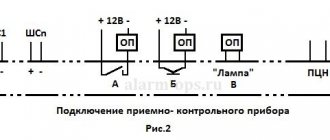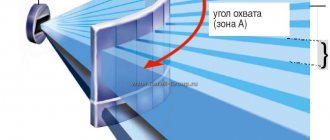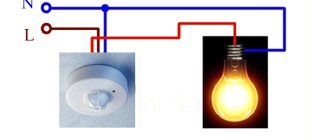Last updated March 10, 2021
A motion sensor is a sensitive device that detects the movement of living (and other) objects in a room, and then sends a signal to the appropriate equipment. Motion sensors were among the first to appear in security alarm systems - where they helped to detect the entry of an unauthorized person into a room or territory, and then turned on an alert. Today, the scope of application of these devices has expanded significantly and has become actively used in private housing for the most peaceful purposes. The introduction of motion sensors is especially active in smart home systems.
Types of motion sensors
There are many classifications of motion-recording devices, but the main principle remains the gradation principle according to the type of device. In order to sense movement, the device needs to register changes in certain parameters. This can be realized in various ways - with the help of microwaves, ultrasonic vibrations and other physical phenomena. Such sensors are active - they constantly emit a stream of radiation, and after the appearance of a moving body they register reflections of wave oscillations.
Expert opinion
Yakovlev Alexey Sergeevich
Electrician with 20 years of experience and extensive experience
In residential premises, including for integration with the Smart Home system, infrared sensors are most often used. They have a number of advantages that make them optimal for performing tasks.
Malfunctions
| The trigger illumination threshold is incorrectly set. | Adjust using the regulator. |
| The sensor window does not track movements. |
|
| The sensor is triggered falsely. |
|
Operating principle of an infrared motion sensor
Heat emitted by living things is radiation in the infrared spectrum. Considering that warm-blooded animals have a body temperature of 30 to 40 ° C, the strength of these rays is quite high and can be recorded by sensitive equipment. Inside the infrared sensor there is usually a system of lenses (in cheaper ones - one segment), which concentrate thermal radiation on a special element - a pyrodetector.
When a certain threshold is exceeded (usually it is set during installation and is largely determined by the sensitivity of the device), the pyroelectric element is triggered and sends a signal to associated devices.
On a note. Heat is emitted not only by living beings, but also by an air conditioner that operates for heating and a heated floor system. Therefore, motion sensors are designed in such a way that they are triggered by an abrupt change - that is, the appearance of a person in the field of view. True, if the sun in the window “shoots” rays into the lens of the infrared sensor, the device will work. That is why it is not placed opposite the window and is always hung from the ceiling.
Device and design of the infrared sensor
Motion sensor device
The design of most devices from different manufacturers is unique. However, the overall scheme necessarily includes several elements.
Optical system
Most often this is a Fresnel lens. It is a set of prismatic facets - microlenses, attached to a convex plate - a cylinder. Each lens detects IR radiation in its area and transmits data to a pyrosensitive element. In this way, a certain configuration of the thermal object is created. If the latter does not move, it does not change. But if the object moves, the same IR flux hits the next microlens as it moves, and the configuration changes. That is, the light sometimes falls on the pyre receiver, sometimes it doesn’t. This is the condition for the sensor to operate: the device reacts to the movement of a person in the field of action.
The more segments in the lens and the higher their sensitivity, the more accurately the IR sensor works.
If a person moves slowly in the sensor operating area, the device may not work, as it considers fluctuations in the IR flux as random changes in the background.
Pyrosensitive elements
The signal from the lens goes to a pyroelectric element - a semiconductor converter. It includes 2 sensors, each of them receives a signal from its own lens. If the flow on both elements is the same, the sensor is inactive, if the signal is different, it is triggered.
Modern models use quad sensors serving 4 lenses. They filter out random light interference more accurately and eliminate false alarms.
Processing module
The processing unit receives information from all pyroelements and analyzes it. Its task is to separate data about a moving thermal object from interference: air movement, sunlight, convection that occurs during operation of an air conditioner or heater, vibration. The sensor should only be triggered by the appearance of a person, and not by animals, which requires additional configuration.
The processing module evaluates the shape and duration of the signal, its amplitude. Normal interference causes asymmetrical bipolar pulses, while the intruder causes symmetrical ones. If the nature of the signal matches the threshold value, the sensor is triggered and sends an impulse to the control panel. The latter is processed by analog or digital devices and activates some program: turn on the lights, increase the intensity, turn on the siren.
In modern models, the sensor additionally measures the duration of the signal and the number of times the threshold is exceeded. This allows you to reduce the number of false alarms and fix the object at a slow speed.
What are the advantages of an infrared sensor
A device that records movement by thermal radiation has significant pros and cons:
pros
Low current consumption. Unlike active sensors that emit ultrasound or microwaves, the infrared sensor belongs to the family of passive sensors; power consumption is very low, which allows it to be installed autonomously, powered by a battery.
There are no false alarms for moving objects other than warm-blooded ones (for example, a robot vacuum cleaner, a swaying curtain by a window).
It can easily be connected to a smart home gateway (hub) or directly connected to a lighting device via an electromagnetic relay.
Minuses
Not too large coverage area (usually up to 10 meters).
Failure to operate at too high or low temperatures.
But it is precisely these shortcomings that are insignificant in indoor use conditions, because there is no frost in the apartment and house, and people do not wear fur coats. As for the coverage area, it is always limited by the dimensions of the room.
These features allow us to consider infrared sensors as the optimal tool for automating smart home scenarios.
Scope of application of the infrared sensor
Scope of application
Motion recorders are used to organize lighting and security systems. Installation is allowed both inside and outside the building:
- in office, public and private buildings;
- on staircases of apartment buildings and in entrances;
- in premises of any type;
- in warehouses;
- in any protected area with a limited area.
Devices designed to operate in harsh weather conditions are equipped with additional protective devices.
Application area
A motion sensor is a universal device that can be used in a wide variety of household areas. The industrial application of such devices is even wider, but this is a separate topic.
Home lighting automation
The most common scenario used in residential premises - apartments and houses. When a motion detector is triggered, the sensor sends a signal to the controller, which turns on the lighting in the corresponding room. This can be either local or general light, as well as all sorts of additional sources: LED strips, bedside area lighting, and more.
The use of lighting sensors to automate turning lights on and off in rooms allows you to save up to 40% on electricity.
Together with the installation of infrared sensors, it is possible to resolve the situation when the owners leave the room, forgetting to turn off the light in it.
Security functions
This use of thermal sensing equipment was a first and continues to produce good results. Using a motion sensor you can:
- Organize the sending of a push message to the owner’s smartphone (the function is activated when leaving the apartment).
- Program the activation of the alarm, including sending an alarm signal to the security post.
- View the time of arrival of family members in the “log” section, where the history of sensor activations is kept.
Climate control
This combination is used less frequently than with lighting, but it also occurs. Based on the sensor signal, devices that maintain the parameters of cold and heat in the apartment can be turned on: batteries or a heated floor system, air conditioning, fan, humidifier and other devices. Thus, maximum energy expenditure occurs only at the right time, and not constantly.
It is worth noting that the widespread use of infrared motion sensors in the field of home climate control is hampered by the phenomenon of thermal inertia. In order to fully warm up a room, it takes time - and this must be done in advance, before entering it. As a result, a comfortable temperature is not achieved immediately, but when this is often not necessary, the person goes to another place.
Usage
Infrared motion sensors are mainly used in the following areas:
- penetration protection;
- lighting automation;
- climate automation.
Intrusion protection
At night, IKDD effectively “identify” persons illegally entering private territory, residential premises, warehouses, etc. At the same time, a siren and bright lighting of the object can turn on. You can also connect a DVR to the warning system. To cover large areas, several DDs are installed.
Light automation
Automatically turning on the lights in rooms when people appear eliminates the waste of electricity during their absence. In dark places on the street, where few passers-by are observed, the sensors turn on the lights while people cross these areas. This saves electricity that would otherwise be wasted on useless lighting.
IR sensor with wireless alarm (bell)
Climate automation
In the matter of automation of temperature conditions in houses and apartments, IR detectors play an important role. They send commands to control units for air conditioners, heated floors and other equipment, depending on the presence or absence of people in the controlled space.
The versatility of IR motion sensors attracts a large number of potential buyers. Ease of installation and operation, durability and low cost of devices - all this makes them the most popular devices on the electrical engineering market.
Criteria for selecting an infrared motion sensor
All devices that are on the market are very similar to each other, however, they also have enough differences that will seriously affect the practice of their use in the smart home system.
Nutrition
All sensors are divided into wired and wireless. The former receive power via a cable, the latter require a battery or even a regular battery for power, which also lasts a long time due to its low power consumption.
On a note. In household wireless sensors for the smart home system, a CR2032 lithium battery is most often used. It lasts on average for one and a half to two years.
Each type has its own advantages: wired devices operate from a constant power supply, but wireless ones are easier to place - there is no need to lay a low-current cable.
Data transfer
Here everything comes down to wires again. Sensors can be connected to the gateway directly, through a system of cables hidden behind suspended ceilings, baseboards or in grooves. Wireless devices connect to the hub via Wi-Fi or Bluetooth. For example, the Aqara system uses a special Zigbee protocol.
Viewing angle
It usually depends on the location of the sensor. Devices that are mounted on the wall usually cover 150 – 180°. If we talk about the ceiling sensor, it has an all-round view and registers any movement in the room within its range.
Radius of action
That is, the range of the device. For household infrared sensors, it rarely exceeds 7–9 meters. However, more is usually not necessary. For outdoor installation, you should choose more powerful and sensitive models with a range of up to 15 m.
Features of accommodation
Most often, sensors are placed either on walls (or any other vertical surfaces) or on the ceiling. The first models have a lens hemisphere in the front part, the second - at the bottom. Sometimes sensors are placed in a corner to achieve optimal coverage.
Some models come with a stand included. This configuration makes both placement options possible.
Photocell equipped
Thanks to an additional photo sensor, the device recognizes the level of illumination and does not turn on the light during the day when it is not required.
What is IR radiation
Before we talk about infrared LEDs, let's understand what infrared (IR) radiation is. Let's take a look at a simplified table of the spectrum of electromagnetic radiation.
It starts with ultraviolet radiation, with a decrease in frequency it first turns into visible light - from violet to red, then into infrared radiation and ends with ordinary radio waves that we use in radio communications. The area designated as the visible spectrum is so called because our eye sees it. All other ranges, which include IR radiation, are invisible.
What is so remarkable about the infrared range? Firstly, it is completely harmless to people and animals. And, secondly, it is absolutely invisible to the human eye, but noticeable to electronic recording systems - from photo receivers to ordinary video cameras. This is why IR LEDs have found such wide application both in everyday life and in production.
Important. The ultraviolet spectrum is also not visible, but, unlike infrared radiation, it has a significant effect on the human body: it can easily damage vision and cause serious skin burns
Additionally, the infrared range is divided into three subranges:
- Near – 0.74…2.5 µm.
- Average – 2.5…50 microns.
- Far - 50...2,000 microns.
Popular motion sensors
Infrared motion sensors today can be purchased both in electrical stores and on various online trading platforms.
REV DDV-3
A small sensor in element format for self-assembly and connection of a motion response system. Designed for hidden installation. Compact, simple, but the range is small. Has a built-in shutdown timer with regulator.
IEK LDD10-009-1100-001
A powerful sensor with a range of 12 m, allowing it to be placed outdoors. Moisture protection is only nominal, against splashes (class IP44), so placement under a canopy is recommended. With fairly large sizes, the regulators are very small - you will need tweezers to adjust them.
IEK LDD11-024-1100-001
Another device from IEK, this time of the hemispherical type. Both wall and ceiling installation are allowed. The switches are located under the cover. It has a built-in relay, but the click is a moderately quiet sound.
REV 15283 5
A classic wall sensor with a range of 12 m, it is intended for placement in long corridors, as well as in areas of private houses. The device “lacks stars from the sky,” but honestly performs all functions. The only disappointment is the small viewing angle – 110°.
TDM ELECTRIC SQ0324-0016
An original solution - the sensor is combined with an E27 socket, screwed into a standard socket and serves as a kind of adapter for the light bulb it controls. It can be a good solution if you need to install only one light source that turns on when moving.
HIPER IoT M1
Good design, excellent sensitivity, convenience and versatility of installation - everything for a smart home system. The communication protocol with the gateway is Wi-Fi, via a router. The disadvantages include a rather long response time, as well as occasional malfunctions that require a reboot.
Aqara Motion Sensor
The sensor interfaces not only with the proprietary Aqara gateway, but also with Apple Homekit, as well as the general Xiaomi MiHome. Thanks to the ball foot, it can be placed anywhere. The software's scripting implementation makes it one of the best options.
When are ICDs used?
The device is primarily designed to record the movement of people. Movements of an object in the viewing area of the infrared motion sensor (IRMD) are detected by photocells of the device head. The signal is sent to the electronic control unit, which, in turn, turns on one or another device through a relay.
Motion sensors are used for various purposes in certain conditions. DD differ in purpose:
- security systems;
- lighting control;
- "Smart Home" system.
Security systems
The problem of protecting local areas and premises in buildings and structures is largely solved by installing an ICD. Control devices work in conjunction with a video surveillance system and sound alarm.
In the absence of the owner, a motion detector installed in the car interior turns on the DVR camera when a person approaches the car. If theft occurs, the driver can then see who did it.
Lighting control
Installed sensors in a house or apartment can significantly save energy costs. Infrared sensors connected to lighting devices in the house or on the street instantly turn on the light when a person appears in the coverage area of the IR detectors.
ICDs that control lighting have three settings options, these are:
- illumination;
- sensitivity;
- delay time.
Illumination
The response of the device to the degree of illumination of the control zone is adjusted with the “LUX” screw. Depending on the installation location, the regulator is turned to a certain position. In enclosed spaces from outside light, the slotted screw is placed opposite the o. If the device should operate at dusk, then the position of the regulator is fixed experimentally.
Sensitivity
Using the “Sens” screw, the IKDD reacts to a certain volume of a moving object. This is especially necessary for outdoor devices so that they do not react to small animals.
Delay time
The delay time is adjusted by turning the “Time” screw. This makes it possible for the lighting to work for some time after the cessation of any movement in the DD field of view. The time period is set in the range from 5 seconds to 10 minutes.
Important! The versatility of using DD allows you to create combined security schemes for various objects. Sensors are installed in vegetable gardens and fields, garages and workshops, warehouses, etc. The IR sensor can simultaneously turn on the light, siren, video camera and wirelessly transmit information to a smartphone.
"Smart Home" system
The Smart Home operating system is becoming increasingly popular among the country's population. The control complex can set the operating modes of various home devices and equipment. Motion sensors are an integral part of this system.
Infrared detectors, when the owners enter the home, transmit signals to the operating system, which can turn on heated floors, ventilation, open curtains on the windows and much more. You can control your Smart Home remotely using your mobile phone.
Question answer
Will the sensor respond to pets?
For small ones - no, but for large ones, over 20 kg - yes. To prevent this from happening, you should reduce the sensitivity.
How is a motion sensor different from a presence sensor?
There are no presence sensors as such - it's just a marketing name for sensitive infrared devices. They read even the slightest movement, creating the illusion of presence recognition.
How to make sure that the light does not stay on for a long time after being turned on by the sensor, for example, on the stairs?
To do this, you need to set a shorter delay - for example, half a minute - this is quite enough to get up.
Operating principle
There is not only one principle of operation of a motion sensor, since there are many motion detectors operating according to different physical principles. For example, by clicking on the link, you can learn more about the operating principle of a microwave motion sensor. Only one of the varieties will be considered in this article - infrared. The functioning of a pyro-receiver (thermal sensor) is based on the interconnection of two sensitive semiconductor elements. When a moving heat source enters the field of view of one, then leaves it and appears on another, the sensor gives an operation signal. To increase the coverage of the action area, and not perceive only objects directly near the sensor, motion-detecting devices use a special polarizing lens placed in front of the sensitive element itself.
Both passive and active infrared detectors are available. The former internally perceive the heat of a moving object, the latter are equipped with special illumination of the working area and capture reflected invisible rays of the spectrum.
We recommend reading: a diagram for connecting a motion sensor using two or three wires, together with switches.











